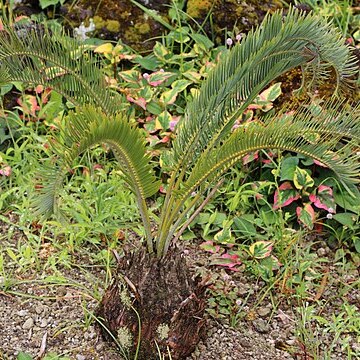Plants unbranched or branched from base; stems 1-3 m tall, occasionally up to 3.5 m, 25-30 cm diam., without loose tomentum. Leaves up to about 1 m long, including petiole about 25 cm long, at first glaucous and densely pale brown woolly except on under surface of leaflets, glabrescent except for tomentose pulvinus; rhachis nearly straight or recurved and sometimes somewhat twisted above middle; leaflets spreading widely in lower half of leaf and in V disposition above middle, not or only slightly overlapping, pungent, entire, reduced in size to base and apex; median leaflets linear, up to 12 cm long and 5-7 mm broad, rarely up to 1 cm, 10-12-nerved on under surface. Cones 2-4 together on short stout peduncles subtended by linear-lanceolate, densely tomentose bracts, covered by a not very dense whitish tomentum. Male cones subcylindric, tapering slightly to base and apex, 30-40 cm long and about 10 cm diam., curved with age; median scales 3.5-4 cm long, 3.4-3.5 cm broad, shortly stalked, slightly cordate at base; bulla face projecting about 1 cm, sharply laterally ridged, with upper facet more or less humped, lower facet rounded, terminal facet concave with the lower margin slightly more prominent than the upper, the short tomentum decreasing in density and length towards the almost glabrous base. Female cones broadly subcylindric, contracted slightly to the rounded apex and very slightly to the base, 20-30 cm long, 10-13 cm diam.; median scales about 4 cm long, 4-4.5 cm broad and 2.5 cm thick vertically, with incurved lateral lobes about 1.5 cm long; bulla face progressively less tomentose to an almost glabrous base, sharply laterally ridged, upper facet rounded but sometimes with 2 slightly prominent ridges, lower facet rounded, terminal facet 1-1.5 cm broad and 5-10 mm wide vertically, concave, with the lower margin slightly more prominent than the upper. Seed orange-yellow, angled by compression, 2.5-2.7 cm long, 2-2.3 cm broad, with short fleshy apex.
More
Plant dioecious, palm-like. Stem aerial or decumbent, 1-5 m tall, unbranched or branched from base, covered by alternating series of woody bracts and persistent, swollen, truncated leaf bases. Leaves petiolate, pinnate with rachis straight or recurved; leaflets pungent-pointed, entire, margins not markedly thickened; reduced in size towards base of rachis. Cones May-Nov., 1-5, appear sessile, velutinous yellowish white. Male cones oblanceoloid. Female cones cylindric to ovoid, broader than male.
Plants unbranched or branched. Stems up to 3 m tall. Cones with a short, greyish tomentum, not conspicuously woolly. Leaves straight, up to 1 m long. Median leaflets up to ± 120 x 5-7 mm, 10-12-nerved on undersurface.


